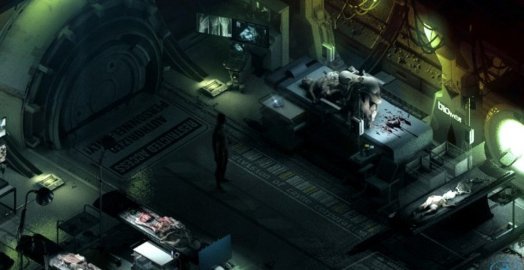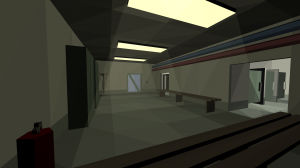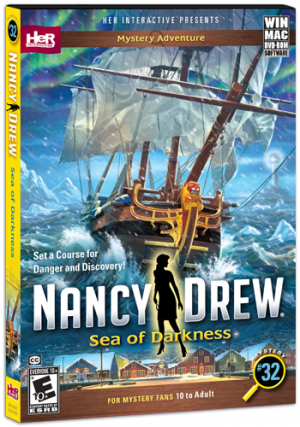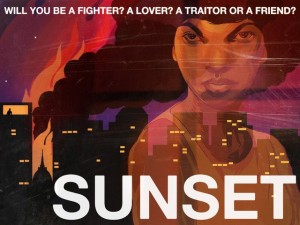Review for STASIS

In space, they say, no one can hear you scream. That's just as well for the Cayne Corporation, whose brand of spectacularly unethical research tends to involve a lot of screaming, not to mention blood. But it also gets results – hulking, shambling, genetically mutated results. Hungry, homicidal results that, right now, might just be the only other living thing on this ship with you. Welcome to STASIS, technically the debut title from indie developer The Brotherhood but mostly a solo effort by the self-described "one-man army" Chris Bischoff, the product of five years' hard work. The end result of all that effort is a big, bold, beautiful game that goes its own way about presenting an intricate and creepy sci-fi take on an otherwise standard survival horror story.
By the mid-22nd century, the Cayne Corporation has gotten tired of governmental oversight and ethics committees. Such squeamishness just gets in the way when you're trying to do really cutting-edge research, and what are the lives of a few down-and-outs when compared to the potential benefits for the whole human race? In the face of such bureaucratic hand-wringing, they did the only thing they could do: refitted an old mining vessel with all the latest lab equipment, staffed it with the most brilliantly sociopathic minds they could find and sent it out into space, beyond the reach of politicians and free to let the end justify the means.
Naturally, it all goes horribly, tragically wrong. By the time the game opens, the ship is adrift in a decaying orbit around Neptune, seemingly derelict. Except not entirely: there are still a few intact stasis pods, one of which houses your character, John Maracheck. For reasons that eventually become clear, the systems reactivate, thaw you out and bring you back to stumbling, gasping life. Why are you here? The last thing you remember, you and your family were going into cryosleep on a shuttle headed for Titan and a family holiday. You certainly weren't aboard the Groomlake (Cayne's cavernous and now-empty research ship). It's time to find out what's going on, find your family and get out of here as fast as possible.
The first thing that strikes you about STASIS is just how stunning the graphics are, followed by the sound design. It's hard to believe that they're the product of just one man: the level of polish and attention to detail is just amazing. Presented in pre-rendered 3D, the display uses an isometric view, looking diagonally down from above. This was a popular technique in the ‘90s (more so in action and RPG games than adventures, but occasionally used in titles such as Sanitarium) and its use here gives the game an unusual and distinctly retro feel.
For all its retro inspiration, however, this is a thoroughly modern game: presented in a crisp HD resolution, the Groomlake is beautifully rendered in a photorealistic style, with every screen full of little details like clutter on a desk, worn deck plating or worrying-looking scratches to make the environment feel like a real place rather than just a 3D model. For a dead ship, it's also surprisingly full of life, with fans spinning, steam rising and scrolling computer screens. The lighting, too, is dramatic but moody, leaving much of the ship in shadow. The only real downside is that, at least for much of the time, you can't get past the fact that you're on a spaceship, all metal walls and floors with a severe and institutional look done in muted blues and greens. You do stumble into hydroponics at one point, though, which is a riot of verdant plant life, and the all-too-rare external views of Neptune's atmosphere are beautiful.
This mix of the retro and the modern also feeds into the technology you run across as you explore. It may be more than a century in the future, but that hasn't stopped the Groomlake's designers from relying on good old-fashioned dials and switches and even what look suspiciously like tube TV displays in places. Sure, they've also got force fields and AI medics and even a "quantum storage device" (more of which in a bit), but there's a definite feeling that technology has been used sparingly and that the simplest solution was often considered the best one. Records left behind suggest that recent history was turbulent, and straightforward reliability counted for more than flashy technology. This isn't a world that was just arbitrarily thrown together; you can see that the developer has a definite vision for the future and has thought through every element of what that would entail.
The sound design is similarly inspired. Music is only used sparingly, to highlight the most dramatic or emotional moments; for much of the time all you hear is your breathing and the sounds of the ship around you. That means the whoosh of fans, the hiss of steam escaping, the creak of the deck plating. Even John's breathing changes with the circumstances, hinting at his escalating stress and distress levels. Just as the graphics are full of animations, so too is the soundscape full of ambient effects that give each area of the ship its own character. The Groomlake's PA system also cuts in regularly with cheerful automated announcements that only help to underscore just how wrong everything is now. When it does come, the music is good too, varying between hauntingly sad and urgently surging. The lullaby John and his wife sing to their daughter during a flashback stuck in my head for days and makes me cry a little even now.
The voice acting, like the music, is sparse but reasonably effective. Object descriptions are given only as text, leaving the voices for when John is talking to himself or to one of the small handful of people he encounters on the ship. The acting itself is mostly good, with only the occasional line coming off a bit flat, but it is perhaps a bit over-serious. Obviously everyone's in the midst of a disaster, but the actors often convey that by delivering each line slowly and with great emphasis, as if this is the most earth-shattering thing they will ever say. As understandable as that is, it's hard to take seriously at times and can drain all the pace out of tense moments.
The interface is a nicely streamlined take on standard point-and-click. Since you meet people so rarely, there are only two actions: look at and pick up/use. Hovering over a hotspot brings up its name near the cursor and a more detailed description in the lower-right of the screen. If all you can do is look, the cursor changes to an eye; if you can interact as well, it becomes a grasping hand. Because the description is always visible in the corner, clicks can be reserved for interaction. The only slight fly in the ointment is that walking (or running, if you double-click) over to an object to interact with it doesn't always work: more often than not, I'd move across and then just stand there, with the cursor stuck in an in-between state that showed the hotspot's name but not its description or the grasping hand. Moving the cursor away and back again sorted things out, but it can be an annoying little speedbump in an otherwise slick system.
The object details deserve special mention, because they read more like passages from a book than typical adventure game descriptions. For example, hover over a locked door at the beginning of the game and you're greeted with, "The white paint has been flaking off for some time, exposing the rusted metal beneath. A red hologram floats silently in the air beside the door, pulsing to indicate the door is locked." As evocative as that is, it's also mostly redundant as you can already see the corroded door and the red hologram for yourself, and guess the rest. Most of the descriptions are like this: beautifully written, adding little to what the gorgeous graphics have already shown you but complementing the atmosphere nonetheless.
Your inventory is unusual too. Just after awaking from cryosleep, a medical AI informs you that your "plug suit quantum storage device is ready for physical record storage". Seemingly, through the magic of quantum mechanics, your suit is able to squirrel away objects without taking up space – pretty handy! (It does have its limits, though, as there are only six slots. Then again, that is always enough.) It's a small thing, but it's nice to see a developer thinking about how you could actually haul around all manner of random junk while wearing only a pocketless, skintight suit without demanding the player just turn a blind eye to it. The device also gets erased at a couple of points, helping to explain why you've conveniently lost your inventory.
Given the emphasis on story and atmosphere, STASIS's puzzles fit in comfortably without standing out. They're mostly inventory-based, with a few machines to operate along the way, and are generally logical and well-integrated into their surroundings. You won't find any mind-benders here: they're almost all focussed on finding a way past the next door or the next obstacle using the tools at hand, and are more about pacing and emphasising John's struggle to get out than quirky lateral thinking. When I got stuck, it was almost always because I'd missed some crucial object or hotspot: there's no pixel hunting as such, but the environments are so detailed that it can be difficult to pick out the objects you can interact with from all the clutter. Some kind of hotspot highlighter would really have been useful at times. Once you've found what you need, though, it's usually pretty clear what to do.
One thing to be aware of, however, is that a few of the puzzles rely on timing or standing in the right place to trigger an event. That's not to say you need great reflexes, just that you sometimes need to wait for the right moment. A particularly frustrating example of this came late in the game when I got badly stuck, only to discover that I had to stand in a seemingly arbitrary spot to trigger an unconnected event that let me continue. When it happened again a few minutes later, though, I was ready for it!
There are also a couple of sequences where you're on the clock and have to figure out the answer before a timer runs out. These are there to inject tension, and the solutions are straightforward once you figure them out, but it did take me a few tries to get past them, with the net result that they were more frustrating than tense. Fortunately, when you die you're reinstated to just before the misstep, though not before a grinding crunch and a screen splattered with blood have rammed the point home. Not surprisingly, there are quite a few ways to die, not to mention several ways to commit suicide if you've had enough, so you'll see that blood spatter fairly regularly.
The Groomlake is enormous, as befits a ship designed to house multiple research projects and hundreds of staff. Once you make it out of "Product Storage" (a holding area for people they find drifting in space and set aside for experimentation like human lab rats), you'll find yourself in the medical bay and then the admin department – both quite civilized, if empty – but as time goes on you'll find yourself going through research labs, crew quarters, hydroponics, a nightclub and a couple of tram stations and other areas too hideous to mention. As you progress, the initial eerie emptiness gives way to increasingly disturbing and then horrific scenes as the nightmare of what’s happened is revealed. All this plays out over 10-12 hours of playtime, ramping up the tension with a well-judged mix of sudden scares and relatively peaceful interludes that lets you get your breath back and process what's going on.
You'll need that processing time, too, because there's an incredibly intricate backstory at play here, worthy of a sci-fi novel. The game lays out a complete future history, explaining the origins of the Cayne Corporation, how and why the Groomlake came to be commissioned, and then the slow descent into madness as one ill-judged project after another went wrong. In fact, there were so many interlocking pieces that I couldn't take it all in on my first playthrough; I'd need to go draw out a timeline and some diagrams to get a grip on it all. None of it breaks any new ground (the idea of unethical research producing deadly consequences in an act of poetic justice is hardly new) but it's carefully and thoughtfully told and unfolds with a slow inevitability that hits home.
If you're wondering how so many details came to be packed in, the answer is PDAs. Lots and lots of PDAs. Seemingly every member of the crew was a budding diarist, and died with a PDA full of entries clutched in their cold, dead hand. The developer has indicated that there are around 55,000 words in the game (equivalent to a shortish novel) and that sounds about right. The bulk of the storytelling is done through these diary entries and emails, and I was torn between being fascinated by them and chafing at the hold-up while I read them all. That said, I'm a bit of a completist and the diaries don't contain any information crucial to making progress – that's reserved for a relatively small number of emails and computer terminals – so if you get bored you can skim or skip them. If you do, though, you'll miss a network of smaller stories, from the janitor's graphic novels to unrequited love and one crewmember's struggle with being gay. The advantage of all these different viewpoints is that you get the stories from all sides, and hear from the ordinary decent folks, worried about what's going on, as well as the psychopaths and megalomaniacs at the root of it all.
One of the most interesting things about the story for me was the insight that just because the results were evil, that doesn't mean everyone involved was. The Cayne Corporation (and their chief scientist, Dr Malan) could have been portrayed as just moustache-twirling baddies. Indeed, when you meet him he comes across as exactly that. However, reading through the diaries of his staff you find an altogether more complex story, full of those who were duped, people wrestling with their consciences, and those who've slowly lost sight of right and wrong in an increasingly toxic atmosphere (metaphorically and literally) – people who've convinced themselves they're making the hard choices to do the research others don't have the stomach for. All in all it's a surprisingly deep and rounded experience for something that could have been a simple tale of cackling evil scientists; it's just a pity that it's mostly told through the awkward medium of diary entries that tend to break the flow of the rest of the game.
If you have even a passing interest in sci-fi horror, STASIS is easy to recommend. It looks and sounds great, and provides more than enough scares and ambient creepiness to satisfy even the most hardened fan. The story may not be the most original but – provided you can live with its obsessive diarists – it's well told and builds to a bittersweet climax. Best played after dark with the lights low and volume up, this is a game that will live in your dreams for a long time.































